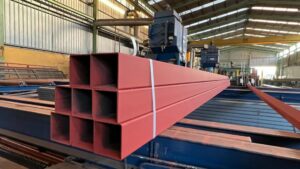
Production in all European Union steel-consuming sectors will decline in 2020 and recover only partially in 2021, according to a market forecast published by European steelmakers’ association Eurofer Aug. 5. However, activity in construction will fall significantly less than activity in other sectors, due to “rather robust” government support, the association said.
The outlook for investment in construction – the biggest steel using sector, expected to account for 35% of the market this year – is “less negative” than in some other industrial sectors, but will only partially alleviate the overall blow the EU’s steel industry will receive from lower demand this year, with overall market conditions not expected to improve before the fourth quarter of 2020 or early 2021, according to Eurofer.
Total output by steel-using sectors is set to fall by 12.8% in 2020 and to recover by 8.9% in 2021, the association said.
Construction output will drop by 5.3% in 2020, and will rebound by 4% in 2021, Eurofer forecast. The construction sector has in recent years been more resilient than others because it is largely protected from the ongoing weakening dynamics in foreign trade. However, in the first quarter of 2020, the onset of the pandemic led to the first drop in construction output since the fourth quarter of 2016 (down 0.9%), it said.
“The construction sector is set to be more resilient and, to some extent, less exposed to the huge repercussions of the COVID-19 lockdown. It is thus likely to achieve relatively better performance than other GDP components in 2020,” Eurofer said. This sector will benefit from government investment and public expenditure which will play a “rather robust, counter-cyclical role,” it said.
Automotive hardest hit
In Q1 2020, production activity in the EU automotive industry fell year-on-year for the sixth consecutive quarter, i.e. by 16% (after being down 6.5% in the fourth quarter). “The combination of already weakening demand for new passenger cars in Europe and in key export markets such as the US, China and Turkey, uncertainty around WLTP and model changes plus – from mid-March 2020 – the outbreak of the COVID-19 pandemic took their heavy toll on production activity in all EU countries,” said Eurofer.
Output in the automotive sector is expected to be hit the most compared to all other steel-using sectors in the course of 2020, with an annual slump of 26% (the most severe on record), followed by a rebound of 25.3% in 2021, it forecast. The automotive sector will account for 18% of the EU steel market this year.
Mechanical engineering
Production in the EU mechanical engineering industry fell 8.6% year-on-year in Q1 (after a drop of 1% in Q4 2019), as a continuation of an existing negative trend, Eurofer said. Mechanical engineering output is expected to fall by 13.4% in 2020 – when it will account for 14% of the EU steel market – and to rebound by 6.8% in 2021.
Tubes
In Q1 2020, output in the EU steel tube industry fell by 13.3%, a much more pronounced fall than the 1.4% recorded in Q4 2019, that had resulted, over the whole year, in a marginal decrease of 0.3%.
The tube industry – to account for 13% of the EU steel market this year – is considered relatively resilient due to links with the construction sector in the EU: however, the outlook for demand for large welded tubes from the oil and gas sector is expected to remain very weak, Eurofer said.
Steel tube output will fall for the second consecutive year in 2020, at a much faster rate than in 2019 (down 19.4% vs down 0.3%). A rebound of 9.8% is foreseen for 2021.
Electrical appliances
Production in the electrical domestic appliances sector dropped by “a severe” 5.2% in Q1, further to a decrease of 0.9% in Q4 2019 that had resulted in an annual output decrease in 2019 of 1.2% (revised, formerly to 1.7%), Eurofer said. The pandemic has further exacerbated the negative trend in production of electrical domestic appliances in the EU recorded since Q3 2018. Output is expected to drop by – 10.8% in 2020 and to recover by 5.7% in 2021. The sector is set to account for just 3% of the EU steel market this year.
Total production activity in EU steel-using sectors increased by “a meager” 0.3% in the whole of 2019, following a decline in Q4 2019 which had been the first drop in output since 2013, Eurofer noted. This compared to an increase of 2.9% in 2018. In Q1 2020 came a drop of 7.2% on year in total steel-using output, due to pandemic-related lockdowns exacerbating the existing negative trend.Overall output in steel-using sectors in Q1 2020 registered negative growth in all EU economies (at different rates across countries) with the sole exceptions of the Czech Republic and Poland, it said.
— Diana Kinch




